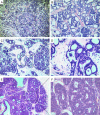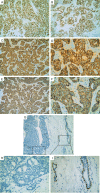Invasive cribriform carcinoma of the breast: a clinicopathological analysis of 12 cases with review of literature
- PMID: 31966881
- PMCID: PMC6965980
Invasive cribriform carcinoma of the breast: a clinicopathological analysis of 12 cases with review of literature
Abstract
Invasive cribriform carcinoma (ICC) is a rare type of invasive breast cancer. We aim to investigate the clinicopathological features, immunophenotypes, diagnosis and differential diagnosis of ICC. Thus, clinicopathological data of 12 ICC patients were collected. All 12 cases were female, aged 38 to 75 years, with a median age of 53 years old. The maximum diameter of the tumor was 2 cm to 10 cm, in which the median tumor size was 2.54 cm in pure ICC and classical ICC. Microscopically, the cancer nests of ICC assumed an invasive, irregular island-shaped distribution, with an irregular mesh structure internally and fibrous reactions around most cancer nests. 67% (8/12) of cases were grade 1 and 33% (4/12) of cases were grade 2 tumors. Immunohistochemically, ER and PR were moderately to strongly positive with the positive tumor cell number accounting for 30% to 95% in all cases. HER-2 was negative in all cases except in one case which was positive (2+). Myoepithelial markers such as Calponin, p63, CK5/6 and CD10 were all negative in the cancer nests. 58% (7/12) of cases had a ki67 index of ≤ 14%. All follow-up patients were followed for 12 to 70 months (with a mean of 42 months), and were disease-free after treatment except for one patient whom we lost during the follow up. In conclusion, ICC, as a special type of breast cancer, has its unique clinicopathological and immunophenotypic characteristics, leading to a good prognosis.
Keywords: Invasive cribriform carcinoma (ICC); breast; immunohistochemistry; invasive ductal carcinoma (IDC).
IJCEP Copyright © 2017.
Conflict of interest statement
None.
Figures


Similar articles
-
Clinicopathological analysis of invasive cribriform carcinoma of the breast, with review of the literature.Ann Diagn Pathol. 2021 Oct;54:151794. doi: 10.1016/j.anndiagpath.2021.151794. Epub 2021 Jul 24. Ann Diagn Pathol. 2021. PMID: 34325338
-
Basaloid carcinoma of the breast: a review of 9 cases, with delineation of a possible clinicopathologic entity.Ann Diagn Pathol. 2008 Feb;12(1):4-11. doi: 10.1016/j.anndiagpath.2007.01.009. Epub 2007 Oct 3. Ann Diagn Pathol. 2008. PMID: 18164408
-
[Low-grade adenosquamous carcinoma of the breast arising from benign sclerosing lesions: a clinicopathological analysis].Zhonghua Bing Li Xue Za Zhi. 2025 Mar 8;54(3):230-236. doi: 10.3760/cma.j.cn112151-20241127-00791. Zhonghua Bing Li Xue Za Zhi. 2025. PMID: 40032413 Chinese.
-
[Primary lung salivary gland-type duct carcinoma: a clinicopathological analysis of two cases and review of literature].Zhonghua Bing Li Xue Za Zhi. 2022 Mar 8;51(3):218-223. doi: 10.3760/cma.j.cn112151-20210604-00410. Zhonghua Bing Li Xue Za Zhi. 2022. PMID: 35249285 Review. Chinese.
-
[Nipple adenoma: report of 18 cases with review of literatures].Zhonghua Bing Li Xue Za Zhi. 2009 Sep;38(9):614-6. Zhonghua Bing Li Xue Za Zhi. 2009. PMID: 20079190 Review. Chinese.
Cited by
-
Invasive cribriform carcinoma of the breast presenting as an erythematous papule on the nipple: A case report.Clin Case Rep. 2024 Jun 4;12(6):e9055. doi: 10.1002/ccr3.9055. eCollection 2024 Jun. Clin Case Rep. 2024. PMID: 38840754 Free PMC article.
-
Rare Breast Cancer Histotypes-A Retrospective Study and Literature Review.J Clin Med. 2024 Jan 23;13(3):643. doi: 10.3390/jcm13030643. J Clin Med. 2024. PMID: 38337337 Free PMC article.
-
Special Types of Breast Cancer: Clinical Behavior and Radiological Appearance.J Imaging. 2024 Jul 29;10(8):182. doi: 10.3390/jimaging10080182. J Imaging. 2024. PMID: 39194971 Free PMC article. Review.
-
Failure to progress: breast and prostate cancer cell lines in developing targeted therapies.Cancer Metastasis Rev. 2024 Dec;43(4):1529-1548. doi: 10.1007/s10555-024-10202-w. Epub 2024 Jul 26. Cancer Metastasis Rev. 2024. PMID: 39060878 Review.
-
A rare case of breast invasive cribriform carcinoma.Radiol Case Rep. 2023 Jan 6;18(3):1049-1052. doi: 10.1016/j.radcr.2022.12.022. eCollection 2023 Mar. Radiol Case Rep. 2023. PMID: 36684641 Free PMC article.
References
-
- Page DL, Dixon JM, Anderson TJ, Lee D, Stewart HJ. Invasive cribriform carcinoma of the breast. Histopathology. 1983;7:525–536. - PubMed
-
- Venable JG, Schwartz AM, Silverberg SG. Infiltrating cribriform carcinoma of the breast: a distinctive clinicopathologic entity. Hum Pathol. 1990;21:333–338. - PubMed
-
- Marzullo F, Zito FA, Marzullo A, Labriola A, Schittulli F, Gargano G, De Girolamo R, Colonna F. Infiltrating cribriform carcinoma of the breast. A clinico-pathologic and immunohistochemical study of 5 cases. Eur J Gynaecol Oncol. 1996;17:228–231. - PubMed
-
- Rakha E, Pinder SE, Shin SJ, Tsuda H. Tubular carcinoma and cribriform carcinoma. In: Lakhani SR, Ellis IO, Schnitt SJ, Tan PH, van de Vijver MJ, editors. WHO classification of tumours of the breast. 4th edition. Lyon: IARC Press; 2012. pp. 43–45.
LinkOut - more resources
Full Text Sources
Research Materials
Miscellaneous
